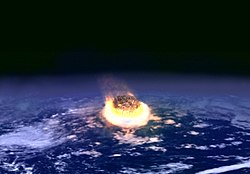
Back اصطدام (علم الفلك) Arabic Toqquşma hadisəsi AZ Імпактная падзея BE Impacte astronòmic Catalan Impakt astronomického tělesa Czech Meteoritnedslag Danish Impakt German Impact event English Impacto astronómico Spanish رویداد برخوردی FA


An impact event is a collision between objects in space. They happen regularly in planetary systems, such as our Solar System. They most often involve small objects, such as asteroids, comets or meteors. These have relatively little impact. When a large object collides with a planet like the Earth, it can have serious effects on the planet. We try to find out when one is going to hit Earth using impact prediction. Depending on the size of the object, much of the impact is reduced by the planet's atmosphere. Smaller objects explode or break apart as they enter the atmosphere. These are seen as bolides.
Impact craters, which are caused by impact events, can be seen on many of the planets and other objects in the Solar System. Some of the largest are on Mars and the Moon. These are said to be evidence of major impact events. The first time an impact event was recorded was in July 1994. A comet, Shoemaker–Levy 9, broke apart and collided with Jupiter.[1] The collision was recorded by telescopes and satellites.[2]
Impact events appear to have had a major effect on the how the Solar System has changed since it was formed. Major impact events have also shaped the history of the Earth, including the evolution of life. It is thought that the Chicxulub impact, which happened 66 million years ago, caused the Cretaceous–Paleogene extinction event.[3][4] There is debate over whether impacts caused any of the other extinction events throughout history.[5][6] A giant impact event is thought to have produced the Moon.[7][8]
Hundreds of impacts have been reported on Earth. Many happen without being seen by anyone on the ground. On average, asteroids with a diameter of 4 meters (13 ft) impact Earth about once per year.[9] These usually explode in the upper atmosphere, and most or all of the solids are vaporised.[10] Asteroids with a diameter of 1 km (0.62 mi) collide with Earth every 500,000 years.[11] Large collisions, of 5 km (3 mi), happen once every twenty million years.[9] Some much smaller asteroids have caused damage and injuries,[12] but no human is known to have been killed directly by an impact.
- The Chelyabinsk meteor event in 2013 is the only impact event known to have resulted in a large number of injuries. It was about 20 metres wide.[13][14]
- One of the most well-known impacts in modern times was the Tunguska event. This happened in Siberia in 1908. Impacts of that size are said to happen about once every thousand years.[15][16]
- S2 (meteorite), c. 3 billion (or c. 3.26) years ago;[17] The crater (from the impact) [was] 500 km wide.[18]
- ↑ "Comet Shoemaker–Levy 9 Collision with Jupiter". National Space Science Data Center. February 2005. Retrieved 2008-08-26.
- ↑ Williams, David R. "Ulysses and Voyager 2". Lunar and Planetary Science. National Space Science Data Center. Retrieved August 25, 2008.
- ↑ Becker, Luann (2002). "Repeated Blows" (PDF). Scientific American 286. 286 (3): 76–83. Bibcode:2002SciAm.286c..76B. doi:10.1038/scientificamerican0302-76. PMID 11857903. Retrieved 28 January 2016.
- ↑ Shukolyukov, A.; Lugmair, G. W. (1998), "Isotopic Evidence for the Cretaceous-Tertiary Impactor and Its Type", Science, 282 (5390): 927–930, Bibcode:1998Sci...282..927S, doi:10.1126/science.282.5390.927, PMID 9794759.
- ↑ Keller G. (2005). "Impacts, volcanism and mass extinction: random coincidence or cause and effect?" (PDF). Australian Journal of Earth Sciences. 52 (4–5): 725–757. Bibcode:2005AuJES..52..725K. doi:10.1080/08120090500170393. S2CID 39063747.
- ↑ Müller R.D., Goncharov A. & Kristi A. 2005. Geophysical evaluation of the enigmatic Bedout basement high, offshore northwest Australia. Earth and Planetary Science Letters 237, 265-284.
- ↑ Canup, R.; Asphaug, E. (2001). "Origin of the Moon in a giant impact near the end of the Earth's formation" (PDF). Nature. 412 (6848): 708–712. Bibcode:2001Natur.412..708C. doi:10.1038/35089010. PMID 11507633. S2CID 4413525. Archived from the original (PDF) on 2010-07-30. Retrieved 2011-12-10.
- ↑ Canup, Robin M. (2004). "Dynamics of Lunar Formation". Annual Review of Astronomy & Astrophysics. 42 (1): 441–475. Bibcode:2004ARA&A..42..441C. doi:10.1146/annurev.astro.41.082201.113457.
- ↑ 9.0 9.1 Cite error: The named reference
Earth-impactwas used but no text was provided for refs named (see the help page). - ↑ Clark R. Chapman & David Morrison; Morrison (January 6, 1994), "Impacts on the Earth by asteroids and comets: assessing the hazard", Nature, 367 (6458): 33–40, Bibcode:1994Natur.367...33C, doi:10.1038/367033a0, S2CID 4305299
- ↑ Bostrom, Nick (March 2002), "Existential Risks: Analyzing Human Extinction Scenarios and Related Hazards", Journal of Evolution and Technology, 9
- ↑ Lewis, John S. (1996), Rain of Iron and Ice, Helix Books (Addison-Wesley), p. 236, ISBN 0-201-48950-3
- ↑ "Asteroid impacts - How to avert Armageddon". The Economist. 15 February 2013. Retrieved 16 February 2013.
- ↑ Kenneth Chang (15 February 2013). "Size of Blast and Number of Injuries Are Seen as Rare for a Rock From Space". The New York Times. Retrieved 16 February 2013.
- ↑ Cite error: The named reference
sciencewas used but no text was provided for refs named (see the help page). - ↑ Cite error: The named reference
Tunguskawas used but no text was provided for refs named (see the help page). - ↑ https://news.harvard.edu/gazette/story/2024/10/what-happened-when-a-meteorite-the-size-of-four-mount-everests-hit-earth/. Retrieved 2024-10-23
- ↑ https://yle.fi/a/74-20119332. Retrieved 2024-10-23